Multiuse Lattice Panels
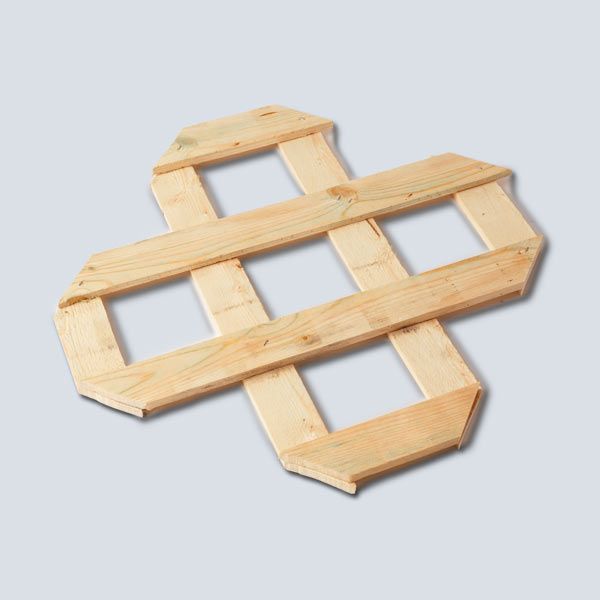
Lattice panels traditionally skirt porches or support climbing vines, but you can repurpose these crisscrossed panels to function as flower beds, pot racks, or memento boards. Lattice can serve as a practical storage solution and give your indoor or outdoor space a stylish touch. Read 10 ways you can use lattice in our guide below so that you can transform your ordinary space into something extraordinary.
1. Edge a Flower Bed with Lattice
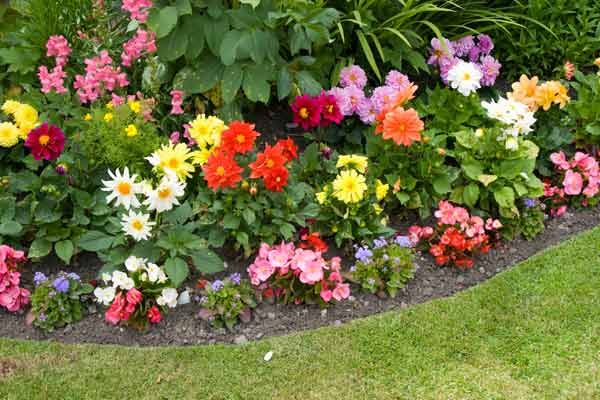
Create a charming border for your flower bed to elevate your garden’s appearance. Follow the steps below to edge your flower beds with lattice:
- Cut pressure-treated lattice panels into 8-inch-wide strips.
- Frame the ends with a lattice cap or C-rail, which is a channeled edging that’s designed specifically for lattice.
- Apply a coat of exterior paint to protect the lattice and match your garden’s color scheme.
- Attach stakes to the lattice strips to keep them stable.
- Install the edging around your flower beds. Confirm it’s level and secure.
Consider integrating colorful flowers along the lattice’s edges to create a vibrant boundary that captures attention and adds depth to your garden design.
2. Paint a Pattern with Lattice
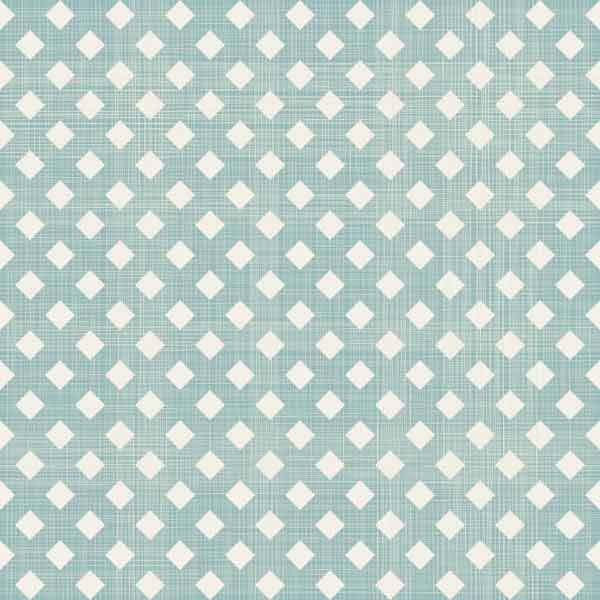
Use lattice as a stencil to create eye-catching patterns on different surfaces. Lattice can help you to add visual interest to walls, floors, or even outdoor spaces. Follow the steps below.
- Choose a lattice panel with a pattern you like.
- Clean and prepare the surface you want to paint.
- Secure the lattice panel firmly against the surface.
- Use spray paint to apply the pattern through the lattice openings.
- Carefully remove the lattice to reveal the geometric design.
Use this method to create square or diamond patterns, which add depth and texture to otherwise plain surfaces. Use contrasting colors for a bold statement or subtle shades for a more understated look.
3. Trim Furniture with Lattice
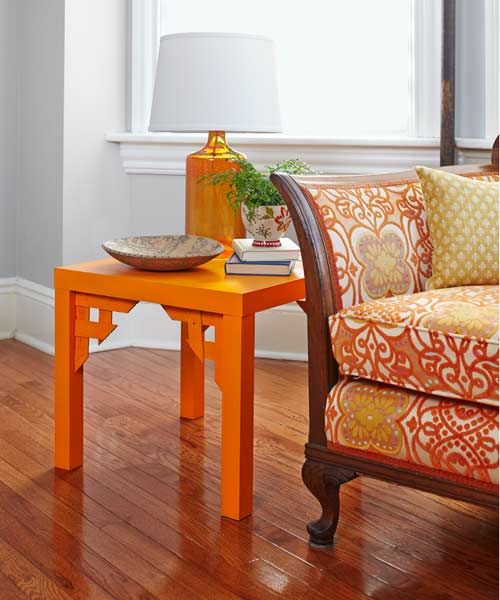
Elevate the look of plain furniture pieces by incorporating lattice as a decorative trim. This can transform ordinary tables, chairs, or cabinets into unique, custom pieces. Follow the steps below.
- Cut triangular pieces of lattice so that they fit the corners of your furniture.
- Create corner braces by placing two 1-by-1-inch lengths in each corner behind the lattice.
- Fasten the corner braces securely to the furniture.
- Nail the lattice onto the corner braces. Make sure there’s a snug fit.
- Paint the lattice trim so that it matches or contrasts the furniture’s finish.
This technique is especially suitable for table corners. You can also apply this method to other furniture pieces, such as dressers, bookcases, headboards, or cabinet doors.
4. Use Lattice as Wainscoting
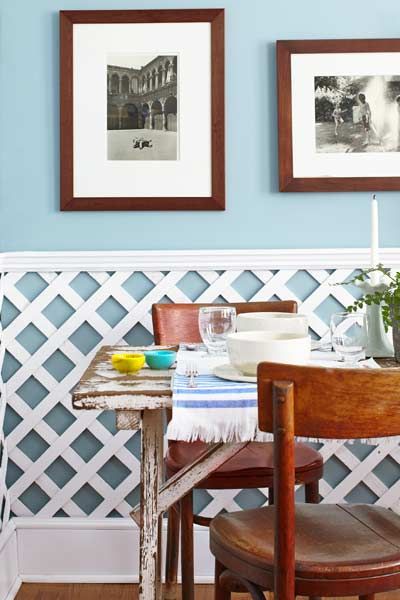
Use lattice as an attractive and cost-effective alternative to traditional wainscoting. Lattice adds texture and character to your walls. Follow the steps below.
- Measure and cut lattice panels to a typical wainscot height, which is about 36 inches.
- Cut the panels where the lattice intersects.
- Install base molding along the bottom of the wall if it’s not already there.
- Set the lattice panels on top of the base molding.
- Use nails and panel adhesive to attach the lattice to the walls.
- Cap the top edge with rabbeted molding to create a finished appearance.
Paint the lattice a color that contrasts the wall for a bold statement, or use a monochromatic scheme for a more subtle, textured look. Hang complementary artwork or sconces to create an inviting atmosphere.
5. Store Garden Tools with Lattice
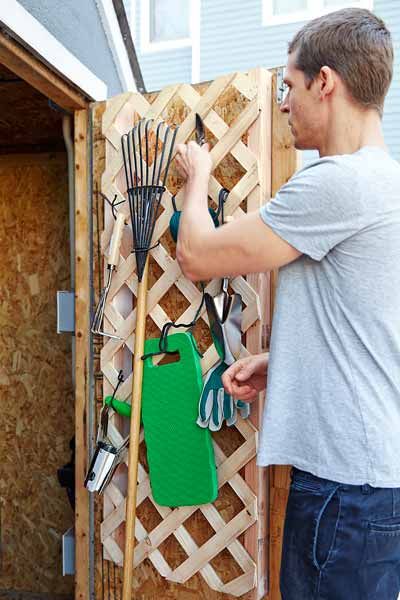
Use lattice to keep your garden tools organized. Follow the steps below.
- Cut a rectangular piece of lattice so that it fits the back of your shed door or wall space.
- Attach the lattice to two two-by-fours for added stability.
- Securely fasten the lattice and two-by-four frame to the door or wall.
- Use zip ties to create loops at various points on the lattice.
- Hang rakes, shovels, and other garden tools using these zip-tie loops.
6. Get Building Materials off the Ground with Lattice

Use lattice to create sturdy storage brackets with which you can store pipes, molding, lumber, and other building materials. Here’s how to construct lattice storage brackets and keep your building materials off the ground:
- Cut two two-by-fours so that they form a right angle.
- Join the two-by-fours with a triangular piece of lattice to create a bracket.
- Screw multiple brackets into the wall. Space them a few feet apart from each other.
- Slide pipes, molding, and other long materials through the lattice openings.
These storage brackets also protect your storage materials from moisture damage that can occur on the ground. Consider weatherproofing the lattice brackets for another layer of protection.
7. Fashion a Pot Rack with Lattice

Create a functional and attractive pot rack with lattice to maximize kitchen storage. This do-it-yourself project is perfect for kitchens with limited cabinet space. Here’s how to make a lattice pot rack:
- Frame a piece of sturdy lattice with two-by-fours to create a stable structure.
- Screw eye hooks into ceiling joists and the wood frame of your lattice panel.
- Connect the eye hooks with chains so that you can suspend the rack from the ceiling.
- Attach S-hooks to the lattice at various points.
- Hang lightweight pots, pans, and utensils from the S-hooks.
This pot rack affords you more storage space and adds a rustic or industrial charm to your kitchen. Be sure to use sturdy lattice and hardware to safely support your cookware’s weight.
8. Make a Lattice Memento Board
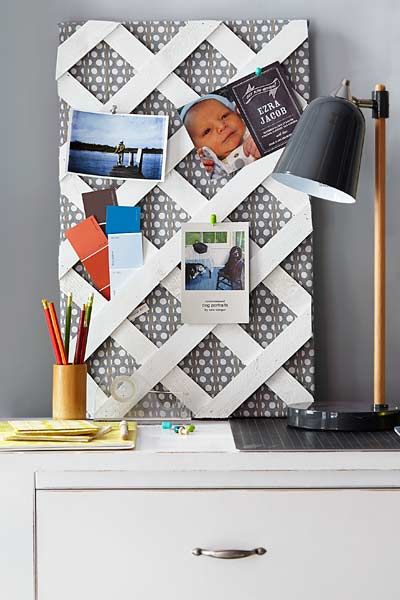
Transform a piece of lattice into a stylish and functional memento board on which you can display photos, cards, and other small keepsakes. This project adds a personal touch to any room and keeps your cherished items organized. Follow the steps below to create a lattice memento board:
- Cut a piece of plywood to the size you want.
- Cover the plywood with batting and fabric. Secure it with a staple gun.
- Cut a piece of lattice so that it fits over the plywood.
- Attach the lattice to the plywood with brad nails.
- Tuck photos, paint swatches, and other mementos into the lattice openings.
This board is perfect for home offices, craft rooms, or children’s bedrooms. Add decorative ribbons or clips so that you can easily rearrange your keepsakes whenever the mood strikes.
9. Create a Decorative Inlay with Lattice
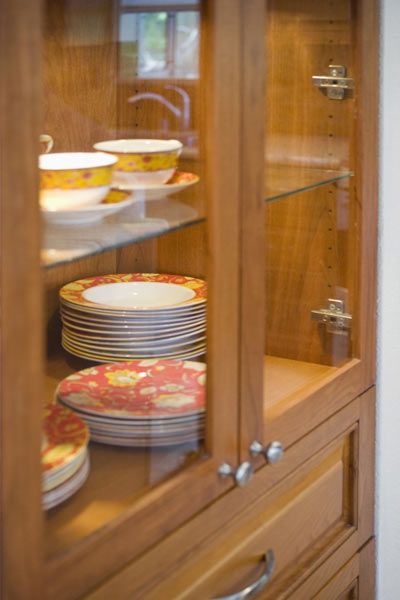
Use lattice as a decorative inlay to add visual interest to cabinet doors or other furniture pieces. This can breathe new life into old furniture or add a custom touch to new pieces. Here’s how to create a lattice inlay:
- Choose a cabinet door or furniture panel for the inlay.
- Cut a piece of lattice so that it fits within the panel. Leave a small border.
- Paint or stain the lattice so that it complements or contrasts the furniture.
- Secure a glass or mirrored panel behind the lattice.
- Attach the lattice to the panel using wood glue and small brad nails.
This technique works well on cabinet doors, and adds texture and depth to kitchen or bathroom cabinetry. You can also use this method on coffee table tops, headboards, or other flat furniture surfaces.
10. Make a Lattice Trivet

Use small pieces of lattice to make a functional and attractive trivet that can protect your countertops and tables from hot dishes. Here’s how to make a lattice trivet:
- Cut a square of lattice to the trivet size you want.
- Sand the edges to prevent splinters.
- Apply a coat of heat-resistant paint to protect the wood and add color.
- Allow the paint to dry completely.
- Add felt or rubber pads to the bottom corners to prevent scratches.
You can create multiple trivets in various sizes and colors to suit different occasions and decor styles. Coordinate the trivets’ colors with your dining table linens or dishware for an especially stylish look.
